Today in unity I learned how to add a completely new feature to my game, this was the player holding a flashlight, doing this was quite simple. Firstly I added a directional light into the scene, once it was inserted I had to make it a child of the main camera within the player. However this was a simple light source and it could not be deactivated. To implement this I created a new C# Script called Flashlight. This script included the code that was required to make it so the user can activate and deactivate the light using the F button on the keyboard.
Once this new feature was added I returned to look at the door and key feature. This could be improved upon; to this I created three new C# Scripts called DoorController, Inventory and Inventory Item. These scripts allow the key to be picked up by the user, and then the user can walk over to the door, click the door and then it opens. In the previous code the key was clicked and the door was destroyed, this greatly differs as the door is not destroyed, it simple opens and the key is now in the players inventory.
Inventory – This is the code that stores the held items, in this case its the key.

InventoryItem – This is what controls the items. When the mouse is clicked while aiming at the key it is picked up.

DoorController – This is what controls the door, when the key is in the users inventory they can go up to the door and open it. Without the key the user cannot open the door.

The door controller script is a component that needs to be added to the door that I want to open and the Inventory script needs to be added to the player and the InventoryItem script needs to be added to the key. The KeyItemName on the Door controller needs to match the InventoryItems itemName so that the key can only interact with that specific door.
Door Animation – To add a bit more detail into the game a piece of code in the DoorController was replaced, originally the doors rotate command was to simply rotate, so the change was instant. However new plugins were added into the Assets called Tweed. This allowed us to replace the code so that the door more realistically.

Other than just adding new features to the game I also replaced the different textures of the objects. Originally the walls and floor were just a solid white, I improved this by downloading and adding a brick texture for the walls and a wooden texture for the floor. I also changed the texture of the table, chairs and key to make it look more realistic, rather than just one solid colour. I also added different scenery such as a painting and crates.
This slideshow requires JavaScript.


































